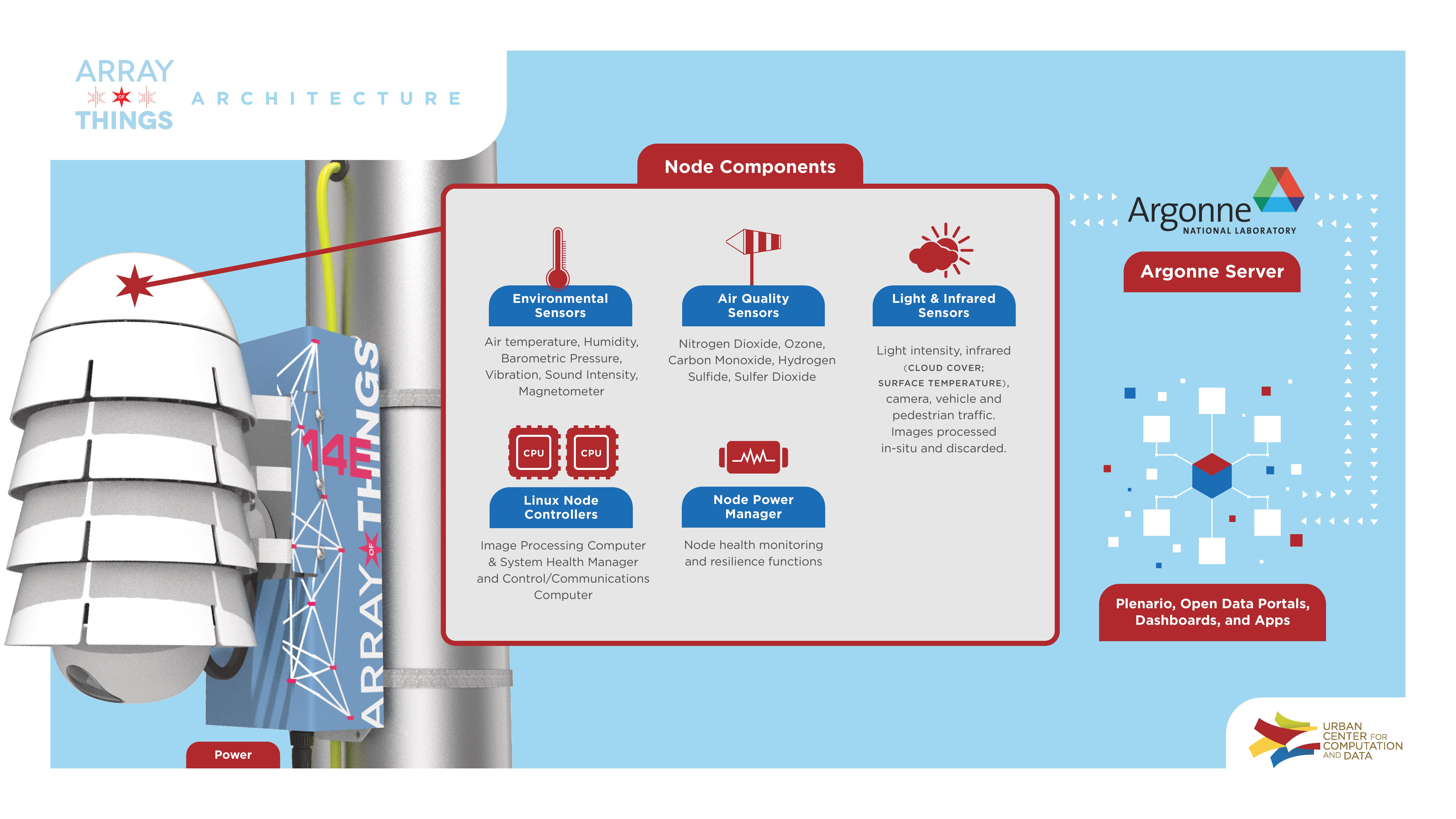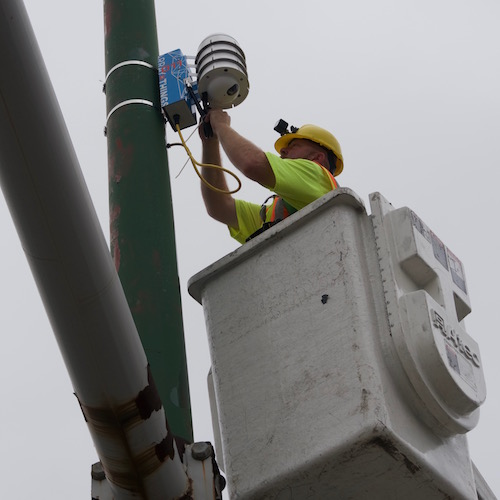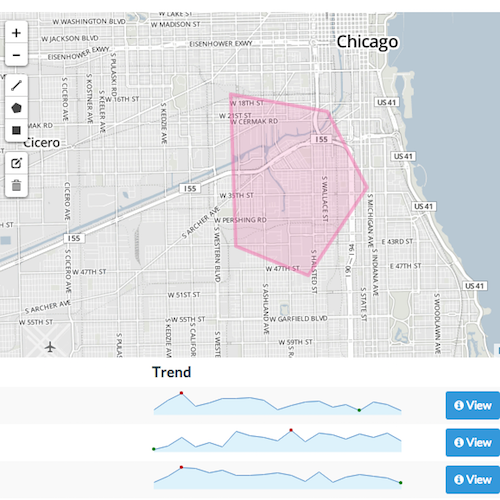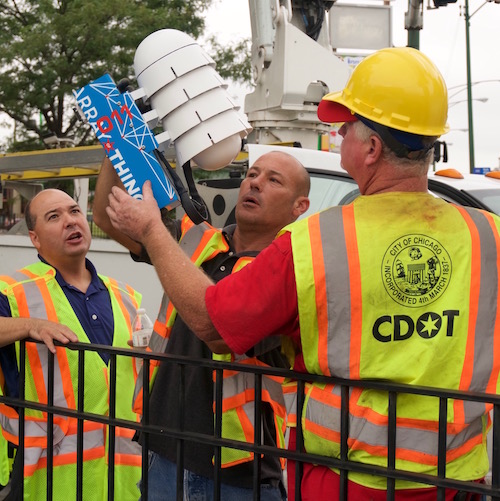The original AoT nodes were retired in September 2021 after many had been in service for 4 years (2 years beyond their planned lifespans). As of 2021 the AoT team is pursuing multiple pathways to build on the seminal project. In 2021 we partnered with multiple Chicago community areas, the City of Chicago, Microsoft Research Urban Innovation team, and JCDecaux on project Eclipse to design an experimental air pollution monitoring network with sensors on 115 Chicago bus shelters. In 2019 the AoT team was part of a national effort led by Northwestern University to develop a new generation of devices based on the Waggle platform used by AoT. The first of those devices were installed in 2021 and more are planned for 2022 and beyond. This national-scale program, funded through the NSF-funded mid-scale research infrastructure program, is called...
 The SAGE team also has a more diverse community of scientists including those interested in measuring
the natural environment and natural disasers. The SAGE platform vision incorporated lessons learned from
the AoT project, NSF's National Ecological Observatory Network
(NEON), UCSD's
WiFire
(wildfire
monitoring) program, and others to create a new generation of Argonne National Laboratory's
Waggle
hardware and software infrastructure.
Called SAGE: A Software-Defined Sensor Network, the new
project created devices with test units replacing a number of original AoT nodes in late 2021. Many
more will be replaced in 2022 as the new platform undergoes extensive testing and evaluation.
SAGE is led by the Northwestern-Argonne Institute for Science and Engineering
(NAISE).
in partnership with
the University of Chicago, Argonne National Laboratory, the University of Colorado,
the University of California-San Diego, Northern Illinois University, the University of Utah,
and George Mason University.
To read more about the AoT and SAGE projects, here are a few of the many papers published by the team.
The SAGE team also has a more diverse community of scientists including those interested in measuring
the natural environment and natural disasers. The SAGE platform vision incorporated lessons learned from
the AoT project, NSF's National Ecological Observatory Network
(NEON), UCSD's
WiFire
(wildfire
monitoring) program, and others to create a new generation of Argonne National Laboratory's
Waggle
hardware and software infrastructure.
Called SAGE: A Software-Defined Sensor Network, the new
project created devices with test units replacing a number of original AoT nodes in late 2021. Many
more will be replaced in 2022 as the new platform undergoes extensive testing and evaluation.
SAGE is led by the Northwestern-Argonne Institute for Science and Engineering
(NAISE).
in partnership with
the University of Chicago, Argonne National Laboratory, the University of Colorado,
the University of California-San Diego, Northern Illinois University, the University of Utah,
and George Mason University.
To read more about the AoT and SAGE projects, here are a few of the many papers published by the team.
- Hands-On Computer Science: The Array of Things Experimental Urban Instrument (Computing in Science & Engineering, 2022)
- Eclipse: An End-to-End Platform for Low-Cost, Hyperlocal Environmental Sensing in Cities (Proceedings of the 21st ACM/IEEE International Conference on Information Processing in Sensor Networks (IPSN), 2022)
- Measuring Cities with Software-Defined Sensors (Journal of Social Computing, 2020)
- Making Sense of Sensor Data: How Local Environmental Conditions Add Value to Social Science Research (Social Science Computer Review, 2020)
- Introducing Sage: Cyberinfrastructure for Sensing at the Edge (European Geosciences Union, Spring (virtual) Meeting 2020)
- Software-Defined Sensors: using Edge Computing to Revolutionize Sensing (American Geophysical Union, Fall Meeting 2019)
- Array of Things: A high-density, urban deployment of low-cost air quality sensors (American Geophysical Union, Fall Meeting 2019)
- Neighborhood scale heat mitigation strategies using Array of Things (AoT) data in Chicago (American Geophysical Union, Fall Meeting 2018)
- Array of Things: Characterizing low-cost air quality sensors for a city-wide instrument (Earth and Space Science Open Archive, 2018)
- Array of Things: A Scientific Research Instrument in the Public Way: Platform Design and Early Lessons Learned (Proceedings of the 2nd International Workshop on Science of Smart City Operations and Platforms Engineering, 2017)
- Waggle: An Open Sensor Platform for Edge Computing (IEEE Sensors, 2016)
What's happening with AoT? What's the future of intelligent urban sensing?
Watch the AoT team's virtual symposium from 20-January-2022 marking the ten-year anniversary of the project's inception.
The AoT symposium was presented by the University of Chicago Mansueto Institute for Urban Innovation and the University of Illinois System's Discovery Partners Institute with speakers included: Charlie Catlett (Argonne National Laboratory and Discovery Partners Institute, AoT PI), Luis Bettencourt (Director, Mansueto Institute for Urban Innovation), Pete Beckman (Argonne National Laboratory and Northwestern University, AoT Co-PI), Kathleen Cagney (University of Michigan, AoT Co-PI), Michael Papka (Argonne National Laboratory and Northern Illinois University, AoT Co-PI), Brenna Berman (Former Chief Information Officer, City of Chicago), Douglas Pancoast (School of the Art Institute of Chicago), Marc G. Berman (University of Chicago), Tiffany Werner (Environmental Law and Policy Center), Daniel Work (Vanderbilt University), Anne Dodge (Mansueto Institute for Urban Dynamics), and Valerie Taylor (Argonne National Laboratory).
View the Event Recording.
View/download the event presentation slides (12MB file).
Welcome to the Array of Things, an intelligent urban measurement project that’s changing our understanding of cities and urban life.
The Array of Things (AoT) is a collaborative effort among scientists, universities, federal and local government, industry partners, and communities to collect real-time data on urban environment, infrastructure, and activity for research and public use. AoT uses an open intelligent sensing and edge computing platform called Waggle, developed at Argonne National Laboratory. AoT was funded primarily by the U.S. National Science Foundation.
Read about the team behind Array of Things and Waggle in IotEvolution
To learn more about the project and its updates, check out:
- our blog or
- follow us on Twitter @arrayofthings.
- You can also explore Array of Things data,
- read about the first Array of Things nodes installed on Chicago intersections,
- watch our introductory video, a video and plenary panel at the 2017 annual Supercomputing conference,
- and read coverage of the project such as from USA Today and CNN.
What is The Array of Things?
What if a light pole told you to watch out for an icy patch of sidewalk ahead? What if an app told you the most populated route for a late-night walk to the El station by yourself? What if you could get weather and air quality information block-by-block, instead of city-by-city?
The Array of Things (AoT) is an experimental urban measurement system comprising programmable, modular "nodes" with sensors and computing capability so that they can analyze data internally, for instance counting the number of vehicles at an intersection (and then deleting the image data rather than sending it to a data center). AoT nodes are installed in Chicago and a growing number of partner cities to collect real-time data on the city’s environment, infrastructure, and activity for research and public use. The concept of AoT is analogous to a “fitness tracker” for the city, measuring factors that impact livability in the urban environment, such as climate, air quality, and noise.

Read more about Array of Things at Bloomberg View, Chicago Magazine, USA Today, the Chicago Sun-Times, and E+D Magazine, or watch a video on the project from WIRED. Array of Things was a nominee for the 2014 Cooper Hewitt People's Design Award.

What is the Goal of the Array of Things?
AoT will provide real-time, location-based data about urban environment, infrastructure and activity to researchers and the public. This initiative has the potential to allow researchers, policymakers, developers and residents to work together and take specific actions that will make cities healthier, more efficient and more livable. The data will help cities operate more efficiently and realize cost savings by anticipating and proactively addressing challenges such as urban flooding and traffic safety.
Because the data is published openly and without charge, it can also support the development of innovative applications, such as a mobile application that allows a resident to track their exposure to certain air contaminants, or to navigate through the city based on avoiding urban heat islands, poor air quality, or excessive noise and congestion.
Array of Things also serves as the flagship deployment of an innovative new type of cyberinfrastructure -- a distributed, programmable system of nodes that can be used to answer critical research questions across different settings and fields of study. AoT is based upon Waggle technology, an open platform for edge computing and intelligent, wireless sensors developed at Argonne National Laboratory. In addition to AoT and other urban research initiatives, Waggle software and hardware supports environmental and atmospheric science in a variety of environments, from the Chicago Botanic Garden to the Atmospheric Radiation Measurement Research Facility in Oklahoma. In October 2019 the Waggle team was awarded a grant from the National Science Foundation for a new project called SAGE: A Software-Defined Sensor Network. SAGE will create a new generation of Waggle node with upgraded sensors and more powerful computing for AI "at the edge." This new node technology will be tested not only in AoT but also in NSF's National Ecological Observatory Network (NEON) with enhanced climate and environmental measurement capabilities, and in the University of Califoria-San Diego's WIFIRE project. NEON operates over 100 environmental measurement sites across the United States, including Alaska, Hawaii, and Puerto Rico, publishing ecological and environmental data to understand pheomena such as the impact of agriculture or urbanization on the natural environment. WIFIRE operates roughly 80 towers across Southern California, providing real-time data for wildfire prevention and response.

What Data is Collected?
The nodes will initially measure temperature, barometric pressure, light, vibration, carbon monoxide, nitrogen dioxide, sulfur dioxide, ozone, ambient sound pressure, and pedestrian and vehicle traffic. Continued research and development is using machine learning to create sensors to monitor other urban factors of interest such as solar light intensity (visible, UV, and IR) and cloud cover (important to building energy management), and flooding and standing water.
The Array of Things project is interested in monitoring urban environment and activity, not individuals. In fact, the technology and policy have been designed to specifically minimize any potential collection of data about individuals, so privacy protection is built into the design of the sensors and into the operating policies.

What Can be Done with AoT Data?
Potential applications of AoT data include:
- Sensors monitoring air quality, sound, and vibration (to detect heavy vehicle traffic) might be used to suggest the healthiest and unhealthiest walking times and routes through the city, or to study the relationship between diseases and the urban environment.
- Real-time detection of urban flooding can improve city services and infrastructure to prevent property damage and illness.
- Measurements of micro-climate in different areas of the city, so that residents can get up-to-date, high-resolution "block-by-block" weather and climate information.
- Observe which areas of the city are heavily populated by pedestrians at different times of day to suggest safe and efficient routes for walking late at night or for timing traffic lights during peak traffic hours to improve pedestrian safety and reduce congestion-related pollution.
Array of Things data and technology will also be available for educational purposes, engaging local students and training them on important job skills. Read more about our educational initiatives and curricula

What Data Is Available?
Data collected by AoT is open, free, and available to the public. The nodes transmit data to a secure central database server at Argonne National Laboratory. Data is then published openly to allow individuals, organizations, researchers, engineers and scientists to study urban environments, develop new data analysis tools and applications, and inform urban planning.
In addition, software, hardware, parts, and specifications will also be published as open source, to encourage participation and oversight from the developer community and public. You can view the architecture and current sensor list of the nodes here. All of the software for the Wagle platform used by AoT is available at the Waggle-Sensor Github page

How is Privacy and Security Protected?
Policy and operational activities are guided by the Array of Things Executive Oversight Committee (EOC), co-chaired by the City of Chicago's Chief Technology Officer, Nick Lucius and the AoT project director (Charlie Catlett, Senior Computer Scientist, Argonne National Laboratory), with additional members from academia, industry, non-profits, and the community. Any changes to privacy, such as additional image processing algorithms or sensors that could potentially have privacy implications, require the approval of the City of Chicago and the AoT EOC, as outlined in the operation of Array of Things is governed by our privacy policies.

When and Where Will Nodes be Installed?
In Chicago, the Array of Things team works with several partners. Development of installation plans is done in consultation with the EOC, which includes City of Chicago officials as well as community leaders and scientists. Most of the nodes to date have been installed by the Chicago Department of Transportation (CDOT), and specifically by office of Electrical Operations. Recent node installations have also been provided by Crown Castle Communications and ComEd as part of a Community Smart MicroGrid project in the Bronzeville neighborhood. The EOC and AoT leadership team solicit input from researchers, neighborhood groups, and community members to determine the best locations for the deployment of AoT nodes. View a map of the current node locations at the City of Chicago Open Data Portal. As of January 2020 there were roughly 130 nodes installed throughout Chicago. The 2020 plan was to upgrade many nodes (some of which were installed as early as 2016) and expand to 150 locations, but the COVID-19 pandemic has put those plans on hold.

Who is the Array of Things Team?
The Array of Things project is led by Charlie Catlett and researchers from the Urban Center for Computation and Data, a joint initiative of Argonne National Laboratory and the University of Chicago hosted by the Mansueto Institute for Urban Innovation at the University of Chicago. The underlying open software and hardware platform, known as Waggle, was developed at Argonne National Laboratory by Pete Beckman (who leades the SAGE project), Rajesh Sankaran, Charlie Catlett, and Nicola Ferrier. The custom enclosure for the nodes was developed by Product Development Technologies, based on early designs from Douglas Pancoast and Satya Mark Basu of the School of the Art Institute of Chicago. The project is a partnership with the City of Chicago.
The Array of Things project has been guided by a series of scientific collaborations and workshops beginning in 2013, with participation from scientists and students from academic institutions around the world. AT&T is the project’s communications partner, providing all AoT connectivity for Chicago. Technical advice and support has come from a many industry partners including AT&T, Arm, BigBelly Solar, Cisco, Crown Castle Communications, Microsoft, Schneider Electric, Intel, Motorola Solutions, and Zebra Technologies.
Array of Things is funded by the National Science Foundation, the Chicago Innovation Fund, the University of Chicago, and Argonne National Laboratory.